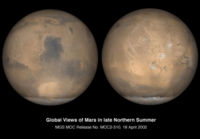Difference between revisions of "Mars Global Surveyor"
m |
|||
| Line 12: | Line 12: | ||
* Monitor global weather and the thermal structure of the atmosphere. | * Monitor global weather and the thermal structure of the atmosphere. | ||
* Study interactions between Mars' surface and the atmosphere by monitoring surface features, polar caps that expand and recede, the polar energy balance, and dust and clouds as they migrate over a seasonal cycle. | * Study interactions between Mars' surface and the atmosphere by monitoring surface features, polar caps that expand and recede, the polar energy balance, and dust and clouds as they migrate over a seasonal cycle. | ||
| + | |||
| + | To achieve this primary objectives, the mission consisted of five principal instruments: | ||
| + | * Mars Orbiter Camera (MOC) - to produce daily wide-angle and narrow-angle images of Mars. | ||
| + | [[Image:moc_mgs.jpg|thumb|right|200px|The Mars Orbiter Camera (MOC) onboard the Mars Global Surveyor: Global views of Mars in the late northern summer (2002).]] | ||
| + | |||
| + | |||
==External links== | ==External links== | ||
| − | + | [http://mars.jpl.nasa.gov/mgs/science/objectives.html MGS mission objectives] | |
[[Category:Missions]] | [[Category:Missions]] | ||
Revision as of 02:08, 8 April 2007
NASA's Mars Global Surveyor was launched on November 7, 1996 from Cape Canaveral Air Station (Florida) on a McDonnell Douglas-built Delta II-7925 rocket. Mars Global Surveyor was the first successful US mission launched to Mars in 20 years since the Viking mission in 1976. On November 2, 2006 it was lost due to loss of power (through incorrect alignment of the solar panels). On arriving into Mars orbit, the Mars Reconnaissance Orbiter made attempts to image the lost Mars Global Surveyor so mission control could diagnose the problem, but the spacecraft could not be found.
Mission Overview
In its highly successful decade of operations, the Mars Global Surveyor orbiter became the longest Mars mission collecting a massive quantity of data about the Martian environment.
The Mars Global Surveyor completed its primary mission to:
- Characterize the surface features and geological processes on Mars.
- Determine the composition, distribution and physical properties of surface minerals, rocks and ice.
- Determine the global topography, planet shape, and gravitational field.
- Establish the nature of the magnetic field and map the crustal remnant field (a crustal remnant field is evidence of magnetism within the planet's crust or rocks, produced by the planet's own magnetic field at the time of formation).
- Monitor global weather and the thermal structure of the atmosphere.
- Study interactions between Mars' surface and the atmosphere by monitoring surface features, polar caps that expand and recede, the polar energy balance, and dust and clouds as they migrate over a seasonal cycle.
To achieve this primary objectives, the mission consisted of five principal instruments:
- Mars Orbiter Camera (MOC) - to produce daily wide-angle and narrow-angle images of Mars.







